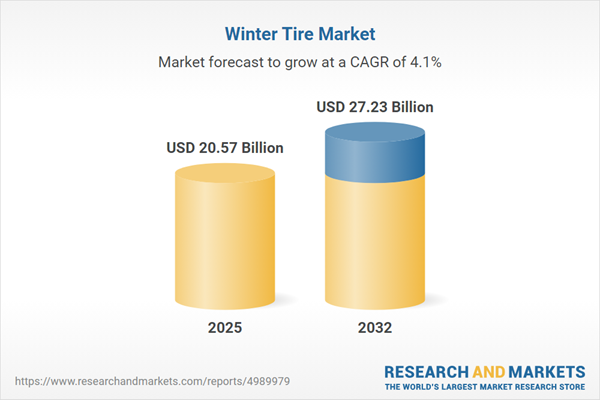Speak directly to the analyst to clarify any post sales queries you may have.
The global winter tire market is experiencing significant shifts driven by innovation, sustainability initiatives, and regulatory changes, demanding agile strategies from industry leaders seeking to secure a competitive edge and manage evolving risk factors.
Market Snapshot: Winter Tire Market Size and Growth
The winter tire market expanded from USD 19.75 billion in 2024 to USD 20.57 billion in 2025, showing continual growth. The market is forecast to reach USD 27.23 billion by 2032, propelled by a CAGR of 4.09%. Steady growth is shaped by changing regulatory frameworks, unpredictable winter weather, and increased adoption of electric vehicles. Ongoing market expansion is supported by strategic product innovation and adaptive business models across multiple global regions as manufacturers respond to shifting consumer and compliance demands.
Scope & Segmentation
This report delivers in-depth insight across market segments and regions, equipping senior leaders with granular intelligence to support evidence-based strategic decisions. Key segmentations include:
- Type: Studded; studless, differentiated for ice- and snow-focused applications, targeting advancements in grip and safety based on varying winter environments.
- Construction: Bias and radial structures, each balancing durability and performance for varied commercial and passenger vehicle requirements.
- Vehicle Type: Passenger cars; light commercial vehicles such as pickups and vans; and SUVs and light trucks, where traction and handling under seasonal conditions are prioritized.
- Application: OEM fitments and replacement channels, encompassing sales via independent workshops, online retailers, tire dealers, and distributors.
- Distribution Channel: A dual approach spanning offline retail via dealerships and specialty stores, and digital sales through e-commerce platforms and manufacturer webstores, aligning with evolving purchasing behavior.
- End User: Fleet operators and individual consumers, each presenting distinct operational requirements and procurement patterns.
- Region: Comprehensive coverage of Americas (including United States, Canada, Mexico, Brazil, Argentina, Chile, Colombia, Peru), Europe, Middle East & Africa (including United Kingdom, Germany, France, Russia, Italy, Spain, Netherlands, Sweden, Poland, Switzerland, United Arab Emirates, Saudi Arabia, Qatar, Turkey, Israel, South Africa, Nigeria, Egypt, Kenya), and Asia-Pacific (China, India, Japan, Australia, South Korea, Indonesia, Thailand, Malaysia, Singapore, Taiwan), providing tailored context for regulatory and commercial decision-making.
- Key Companies: Analysis focuses on leading industry players such as Bridgestone Corporation, Compagnie Générale des Établissements Michelin S.C.A., Continental Aktiengesellschaft, The Goodyear Tire & Rubber Company, Pirelli & C. S.p.A., Yokohama Rubber Co., Ltd., Hankook Tire & Technology Co., Ltd., Nokian Tyres plc, Sumitomo Rubber Industries, Ltd., and Kumho Tire Co., Inc., benchmarking product innovation and supply agility.
Key Takeaways for Senior Decision-Makers
- Developments in advanced rubber compounds and refined tread patterns continually raise safety standards, directly responding to increasingly erratic winter climates and heightening end-user expectations.
- The electrification of vehicles drives significant R&D in winter tires that optimize rolling resistance for electric platforms, ensuring vehicle efficiency without compromising safety.
- Digital transformation affects purchase, supply, and aftersales, with integrated tire sensor technologies and online commerce channels redefining how customers interact throughout the tire lifecycle.
- Regional legislative distinctions in North America and Europe shape market entry and influence OEM and aftermarket supply, requiring careful strategic alignment on compliance and distribution.
- Heightened sustainability requirements encourage the advancement of bio-based elastomers and greater use of recycled materials, moving the sector toward environmentally aligned operational practices.
Tariff Impact: United States 2025 Policy Shift
Upcoming U.S. tariffs in 2025 are compelling manufacturers to restructure supplier networks and adopt diversified sourcing strategies across Latin America and Southeast Asia. Adjustments to production schedules and expanded service bundling within distribution are increasingly common as short-term cost volatility persists. Strategic alliances with logistics specialists and purchasing partners help mitigate interruptions in supply and sustain product quality through policy-driven disruptions in the winter tire market.
Methodology & Data Sources
Comprehensive analysis in this winter tire market report is based on primary research, including interviews with OEM engineers, supply chain experts, and regional distributors, as well as end-user survey data. Secondary information is sourced from industry publications, regulatory documents, and disclosures from major manufacturers. Findings are rigorously validated using triangulation and advanced data analytics.
Why This Report Matters
- Delivers actionable intelligence on technological, regulatory, and digital advances to inform strategic planning and operational decision-making for senior executives.
- Clarifies how regional complexities and supply chain constraints influence market progression and competitive positioning, supporting robust entry and risk mitigation strategies.
- Distills essential trends in product development, consumer demand, and competitive response, providing practical insight for prioritizing commercial investments in the winter tire sector.
Conclusion
The winter tire market landscape requires companies to embrace real-time intelligence and operational agility. Those who continuously align technology, supply chain capabilities, and regulatory insight will sustain leadership in a rapidly evolving environment.
Additional Product Information:
- Purchase of this report includes 1 year online access with quarterly updates.
- This report can be updated on request. Please contact our Customer Experience team using the Ask a Question widget on our website.
Table of Contents
3. Executive Summary
4. Market Overview
7. Cumulative Impact of Artificial Intelligence 2025
List of Figures
Samples

LOADING...
Companies Mentioned
The key companies profiled in this Winter Tire market report include:- Bridgestone Corporation
- Compagnie Générale des Établissements Michelin S.C.A.
- Continental Aktiengesellschaft
- The Goodyear Tire & Rubber Company
- Pirelli & C. S.p.A.
- Yokohama Rubber Co., Ltd.
- Hankook Tire & Technology Co., Ltd.
- Nokian Tyres plc
- Sumitomo Rubber Industries, Ltd.
- Kumho Tire Co., Inc.
Table Information
| Report Attribute | Details |
|---|---|
| No. of Pages | 187 |
| Published | October 2025 |
| Forecast Period | 2025 - 2032 |
| Estimated Market Value ( USD | $ 20.57 Billion |
| Forecasted Market Value ( USD | $ 27.23 Billion |
| Compound Annual Growth Rate | 4.0% |
| Regions Covered | Global |
| No. of Companies Mentioned | 11 |









